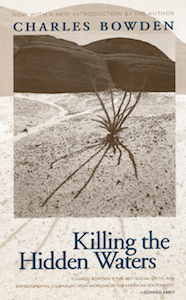When Charles Bowden’s Killing the Hidden Waters was first published in 1977, the population of Arizona – the U.S. state in which he was then living and part of the region in which so much of his narrative takes place – was a little under two-and-a-half million people. In 2003, the year in which his new introduction “What I Learned Watching the Wells Go Down” was added to the fifth paperback printing of the book, the state’s population had risen to over five million. Most who read it thought it both inspired and brilliant, but according to his opening words in the new introduction, he “went wrong:”
The faucet in the kitchen always becomes the reality we believe, and the periodic droughts, one of which for much of the nineties as savaged the West, remain a fantasy. This happens each and every day as the water roars from the faucet and the skies remain dangerously blue. We believe in the immediate moment and decide the future can and will magically take care of itself.
When Bowden originally wrote Killing the Hidden Waters, he intended it to be a primer for any and all interested in a subject that – while as basic as the resources we need to survive can be – can admittedly be a bit, if you’ll pardon the pun, dry when presented in the conventional form in which such things most commonly are explained. But as he has since proven many times over in his many essays and books published since then, Bowden is not one to approach his subjects in any way that could ever be described as common, and his prose is as far from dry as the bottom of the Pacific ocean is from the surface of the Sonoran desert.
Combining the factual precision of the historian, the keen analysis of the sociologist, and the lyricism of the finest story-teller, Bowden approaches the subject of usable water resources not with a recitation of modern-day statistics but by painting the reader a portrait of the Papago – or desert O-otam, a Piman people of the Sonoran desert “who once lived completely in balance with their water resources but now live out of balance with them.”
Living in one of the driest and, by modern standards, inhospitable places on the face of the planet, the O-otam not only lived in but survived because of their desert home for thousands of years. What’s more, they did so without ever tapping the groundwater beneath their feet; the groundwater now so beyond over-exploited by the present-day residents of Phoenix, Tucson, and the rest of southwestern Arizona. Then one day a well-meaning but woefully misinformed outsider drilled a well…
Winding through the cultural histories and practices of the pre-European peoples of the desert southwestern U.S. and northwestern Mexico – as well as some others whose cultures, such as the Comanche, also mostly conformed (albeit in very different ways) to the limits placed upon them by the resources of the region, Bowden leads the reader into a deeper understanding of the ecological dynamics of surface and groundwater in arid environments. To this he also makes clear the more subtle but very important idea that “resource problems are almost always cultural problems and not the result of scarcity.”
The O-otam and their pre-European conquest neighbors developed cultures that – until recently – respected the limitations dictated by the land. The Comanches developed a culture that took into account their respective power to live off the products of other nearby peoples – most of whom themselves lived in balance with the limitations of the land. The European settlers developed a culture that employed technology to live far beyond the capacity of the land. In the case of the water resources of the desert southwest (as well as most everywhere else today) the last of these began tapping deep into the water from the past and borrowing against the future to satisfy the ever-increasing demands of the present.
As of the 2013, the estimate by the U.S. Census of the human population of the state of Arizona is 6,626,624, an increase of 3.7% from that same agency’s 2010 estimate. While some have personally begun to heed the call for conservation in the conduct of their individual lives, the growing demand for water in the state increasingly requires the diversion of water from the rivers flowing across the lands of many other western states. The dominant human culture of the region is now so far out of balance with the limits of the land that all the personal actions of everyone in the state will not put things right; the culture itself must change if all the resource debt already incurred is ever to be repaid even in part.
As Bowden so eloquently closes his new introduction to this present edition, “Welcome to the future, the place that will make us face the experiences of our past.”
 Title: Killing the Hidden Waters
Title: Killing the Hidden Waters
Author: Charles Bowden
Publisher: University of Texas Press
Format: Paperback
Pages:206 pp. with 36 illustrations
ISBN: 978-0-292-74306-9
Published: originally 1977, this edition 2003
In accordance with Federal Trade Commission 16 CFR Part 255, it is disclosed that the copy of the book read in order to produce this review was provided gratis to the reviewer by the publisher.
